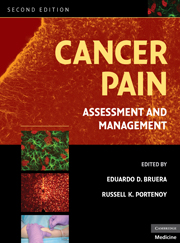Book contents
- Frontmatter
- Contents
- Contributors
- Preface
- SECTION I MECHANISMS AND EPIDEMIOLOGY
- SECTION II EPIDEMIOLOGY AND SYNDROMES
- SECTION III ASSESSMENT
- SECTION IV PHARMACOLOGICAL TREATMENT
- SECTION V OTHER INTERVENTIONAL STRATEGIES
- SECTION VI REHABILITATION AND PSYCHOLOGICAL INTERVENTIONS
- SECTION VII THE ROLE OF ANTINEOPLASTIC THERAPIES IN PAIN CONTROL
- 20 Palliative radiotherapy
- 21 Palliative systemic antineoplastic therapy
- SECTION VIII PAIN IN SPECIAL POPULATIONS
- SECTION IX DIFFICULT PAIN PROBLEMS
- SECTION X SYSTEMS OF CARE
- Index
- Plate section
- References
21 - Palliative systemic antineoplastic therapy
from SECTION VII - THE ROLE OF ANTINEOPLASTIC THERAPIES IN PAIN CONTROL
Published online by Cambridge University Press: 06 July 2010
- Frontmatter
- Contents
- Contributors
- Preface
- SECTION I MECHANISMS AND EPIDEMIOLOGY
- SECTION II EPIDEMIOLOGY AND SYNDROMES
- SECTION III ASSESSMENT
- SECTION IV PHARMACOLOGICAL TREATMENT
- SECTION V OTHER INTERVENTIONAL STRATEGIES
- SECTION VI REHABILITATION AND PSYCHOLOGICAL INTERVENTIONS
- SECTION VII THE ROLE OF ANTINEOPLASTIC THERAPIES IN PAIN CONTROL
- 20 Palliative radiotherapy
- 21 Palliative systemic antineoplastic therapy
- SECTION VIII PAIN IN SPECIAL POPULATIONS
- SECTION IX DIFFICULT PAIN PROBLEMS
- SECTION X SYSTEMS OF CARE
- Index
- Plate section
- References
Summary
Introduction
Palliative care for patients with advanced cancer centers on alleviating suffering and promoting quality of life. Understandably, the emphasis of palliative care is on mitigating the impact of the malignancy on the individual rather than persisting in the direct battle against the cancer. In this shift toward palliation, patients and providers sometimes lose sight of the potential value that anticancer therapy can provide in terms of relieving symptoms and preserving function. Conversely, as advances in medical oncology have led to improved outcomes in a number of tumor types, enthusiasm for new cancer therapies must be tempered by the very real drawbacks of such therapies. Systemic anticancer therapy such as chemotherapy, hormonal therapy, or other modalities (e.g., targeted therapy, immunotherapy) may expose the patient with advanced cancer to significant risks. In addition to toxicity-related risks, added expense and the loss of valuable time and energy, which could be utilized in other ways, are other important factors to consider. The uncertainty regarding outcomes and the complexity involved in making treatment decisions have made the issue of palliative systemic therapy controversial and, at times, a source of conflict between providers and family members.
From the provider's perspective, the intricacy and heterogeneity of cancer have become increasingly daunting, as recalling the varied natural histories and ever-changing treatment strategies for even the most common tumor types is difficult for all medical practitioners, including medical oncologists.
- Type
- Chapter
- Information
- Cancer PainAssessment and Management, pp. 399 - 420Publisher: Cambridge University PressPrint publication year: 2009



